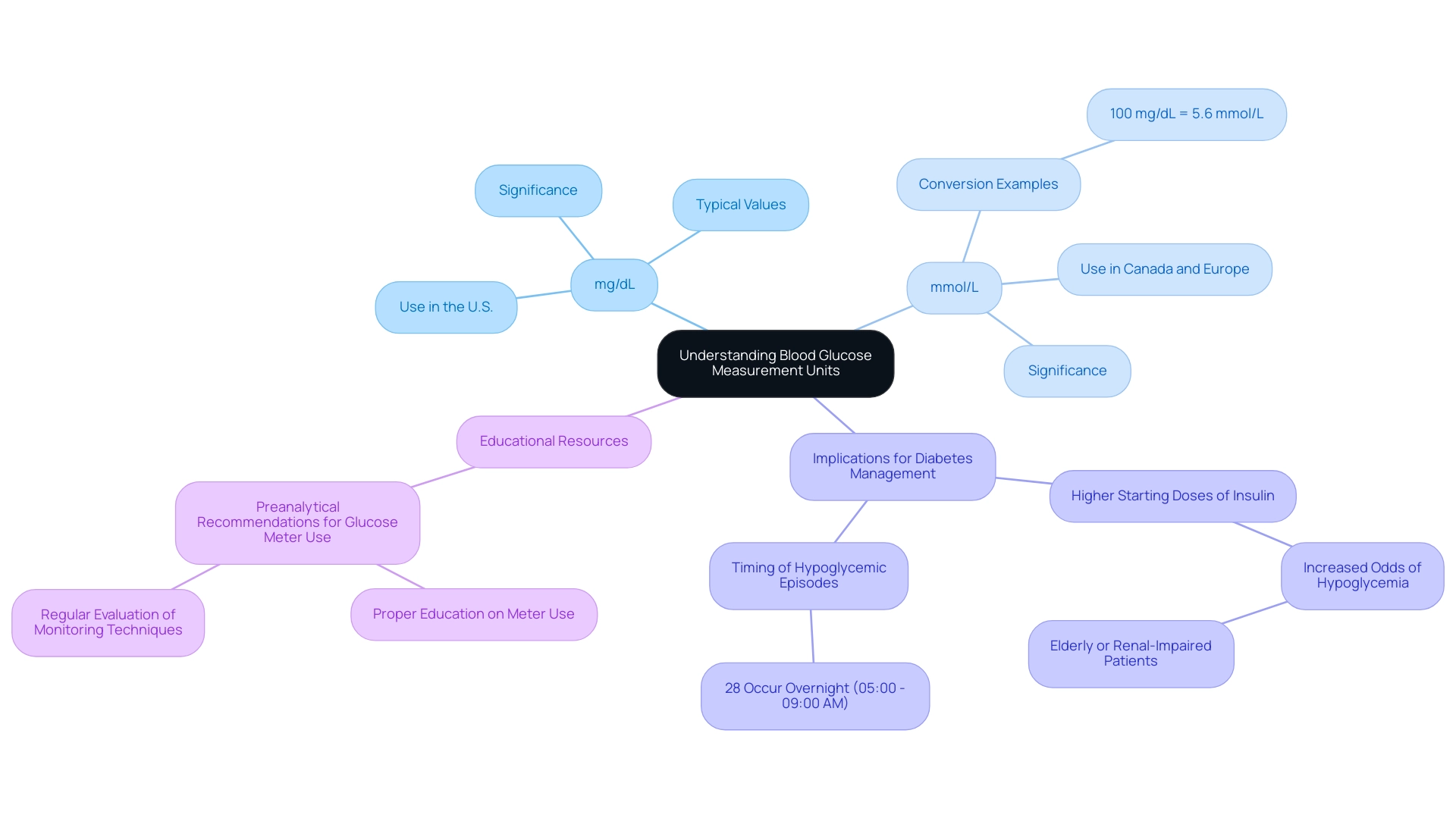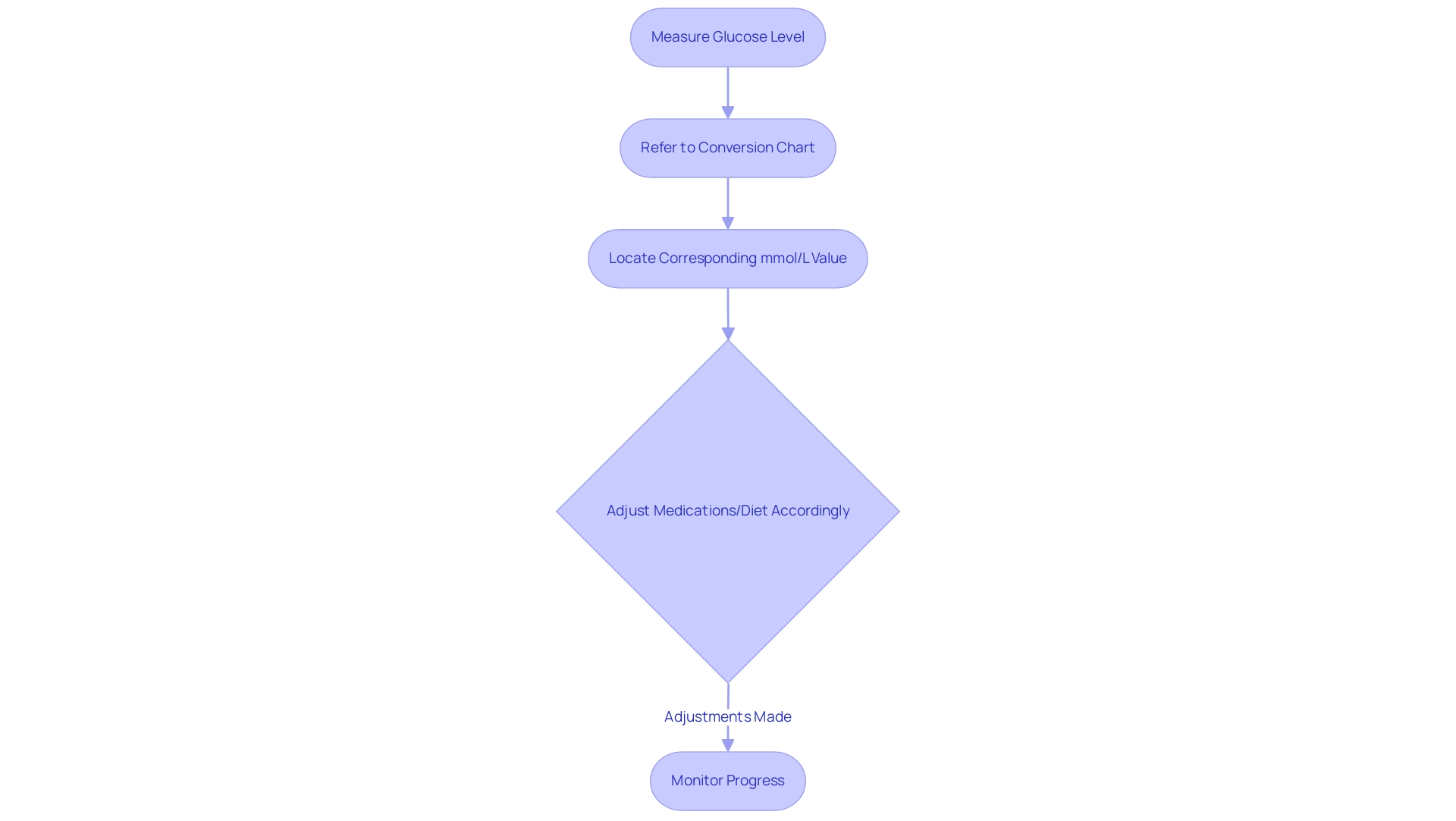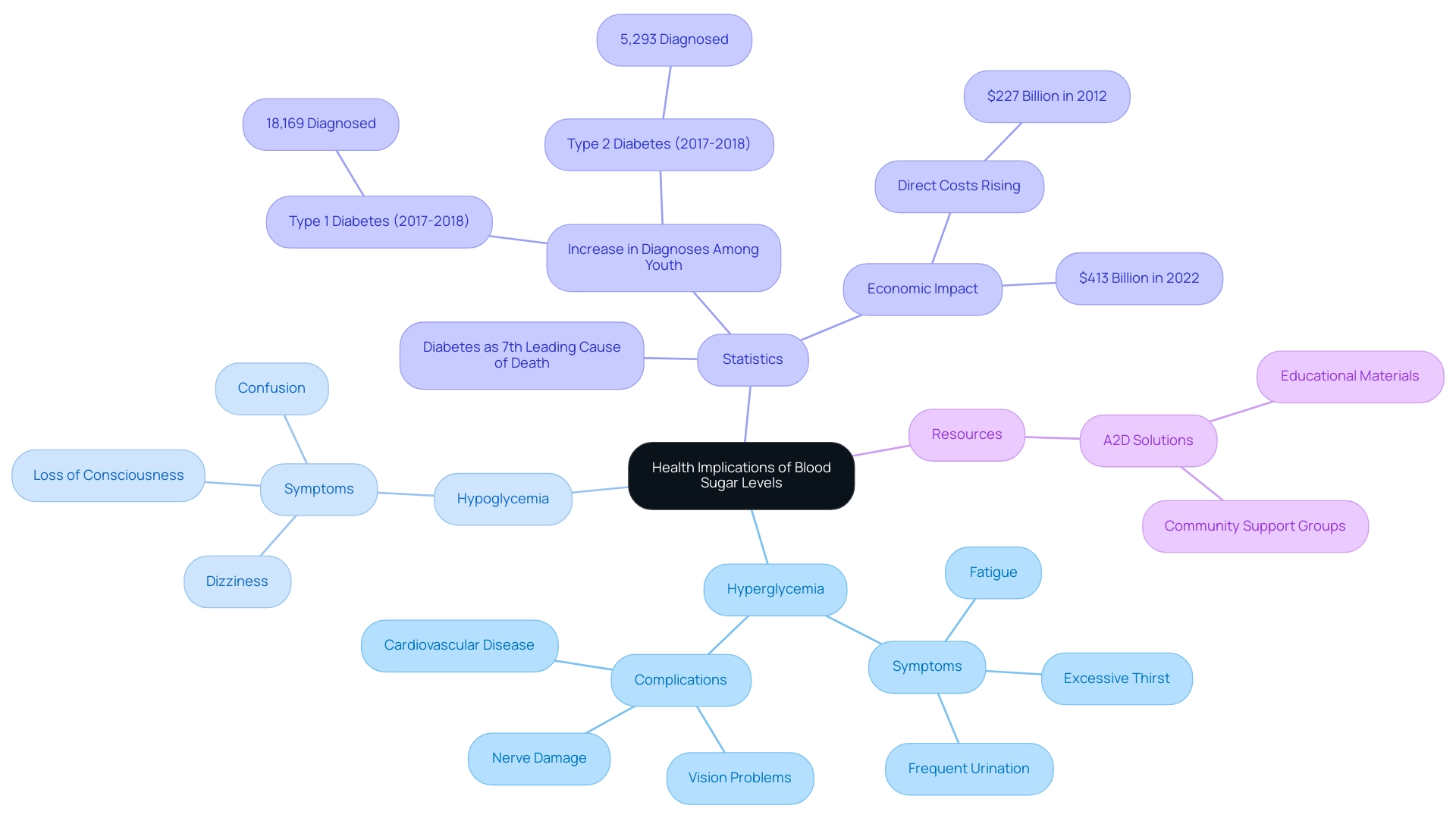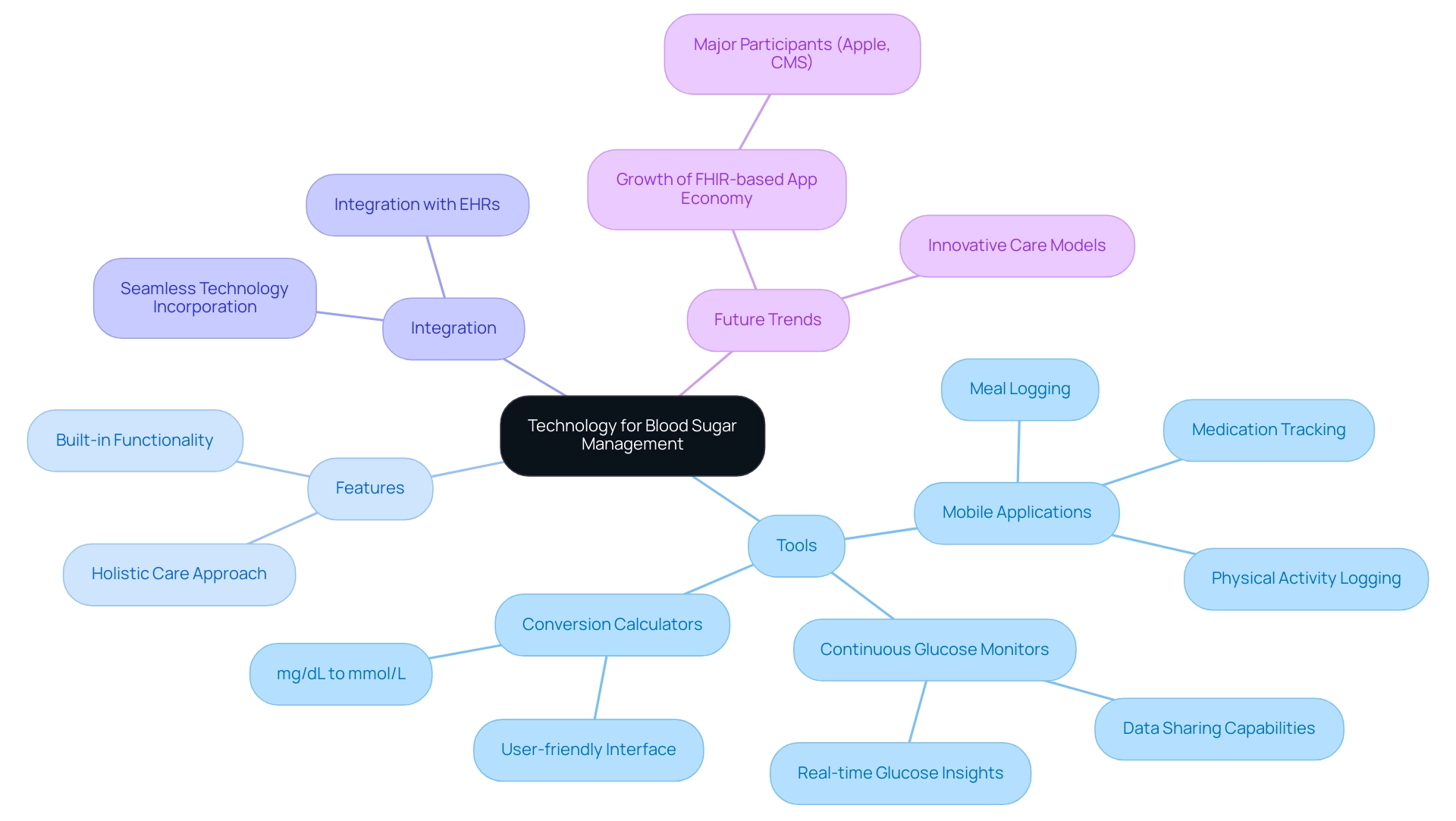Overview
A blood sugar conversion chart is a crucial tool for diabetes management, allowing individuals to easily convert glucose readings between different units (mg/dL and mmol/L), which is essential for accurate interpretation and communication with healthcare providers. The article emphasizes the importance of understanding these conversions to make informed health decisions, as well as the significant economic and health implications of diabetes, highlighting the need for effective management strategies and resources like T2DSolutions to support patients in their care.
Introduction
In the realm of diabetes management, understanding blood sugar levels is not just beneficial—it's essential. As the prevalence of diabetes continues to rise, so does the need for effective tools that empower individuals to take control of their health.
Blood sugar conversion charts stand out as invaluable resources, enabling patients to navigate the complexities of different measurement units and make informed decisions about their care.
With the launch of T2DSolutions, a comprehensive hub for Type 2 and Type 3 diabetes education, patients will gain access to vital information, community support, and innovative technologies designed to enhance their management strategies.
This article delves into the significance of blood sugar monitoring, the implications of various measurement units, and the transformative role of technology in empowering patients on their journey to better health.
Defining Blood Sugar Conversion Charts: A Key Tool for Diabetes Management
Blood sugar conversion charts act as essential tools for individuals handling diabetes, offering a simple method to convert glucose readings between different measurement units—specifically from milligrams per deciliter (mg/dL) to millimoles per liter (mmol/L) and vice versa. This necessity arises from the fact that various healthcare providers and regions may utilize different units, potentially leading to confusion and misinterpretation of glucose levels. As noted by Debra Sullivan, Ph.D., R.N., CNE, COI,
If anyone has concerns about their sugar levels, they should seek medical attention.
Such guidance reinforces the importance of having a clear understanding of one's blood glucose readings. The economic effects of handling this condition are substantial; for example, additional medical expenses per individual linked to this illness rose from $10,179 to $12,022 between 2012 and 2022. Furthermore, the occurrence of type 2 health condition has significantly risen across all racial and ethnic groups from 2002 to 2018, emphasizing the urgent need for effective control tools.
By effectively utilizing the blood sugar conversion chart, patients can accurately interpret their levels and make informed decisions regarding their health care, including dietary adjustments, medication adherence, and lifestyle modifications. T2DSolutions aims to serve as a comprehensive resource hub, offering educational materials and tools that empower patients to manage their condition effectively. A recent case study estimated the total direct and indirect expenses of diagnosed blood sugar conditions in the U.S. in 2022 at $413 billion, emphasizing the significant economic burden and the importance of effective strategies for handling the condition.
This essential knowledge plays a vital role in the overall handling of the disease, contributing to improved health results and enabling patients to take charge of their condition.

The Importance of Monitoring Blood Sugar Levels in Diabetes
Efficient control of health conditions fundamentally depends on the regular observation of glucose levels. Regular assessments yield essential insights into how various factors—such as food intake, physical activity, medications, and stress—affect glucose levels. As T2DSolutions launches, it aims to serve as a comprehensive resource hub for individuals recently diagnosed with Type 2 and Type 3 conditions, offering valuable tools such as a blood sugar conversion chart, meal planning guides, and medication tracking resources, alongside community support for effective management.
The age-adjusted prevalence of diagnosed conditions related to high blood glucose has increased significantly from 5.9% in 1999–2000 to 10.1% as of August 2023, underscoring the growing need for individuals affected to maintain their glucose levels within target ranges to avert serious health complications, including neuropathy, cardiovascular disease, and kidney damage. Furthermore, gaining a thorough understanding of glucose fluctuations empowers patients to make informed decisions regarding their treatment plans. T2DSolutions will provide essential resources and a blood sugar conversion chart to facilitate this proactive approach, dramatically enhancing quality of life and mitigating the risks associated with long-term health issues arising from blood sugar disorders.
Remarkably, a considerable segment of adults with high sugar levels also encounter increased A1C levels and hypertension, as emphasized in a study revealing that 80.6% of adults with high sugar levels had a systolic pressure of 130 mmHg or greater or were on medication for elevated pressure. This highlights the urgent requirement for thorough oversight strategies that prioritize efficient glucose monitoring, which T2DSolutions is dedicated to tackling. Additionally, T2DSolutions will foster community engagement through forums and support groups, allowing patients to share experiences and strategies.
As Lara J. Akinbami states, 'All material appearing in this report is in the public domain and may be reproduced or copied without permission; citation as to source, however, is appreciated,' reinforcing the importance of sharing knowledge and strategies in managing diabetes-related conditions.

Understanding Measurement Units: mmol/L vs. mg/dL
at&t Solutions, we acknowledge that comprehending blood glucose levels is essential for recently diagnosed individuals managing their condition. Blood sugar levels are quantified using two primary units: milligrams per deciliter (mg/dL) and millimoles per liter (mmol/L). In the United States, mg/dL is the conventional standard, while many other regions, including Canada and various European countries, predominantly utilize mmol/L.
This distinction is not merely mathematical; it plays an integral role in effective diabetes management. For instance, a glucose level of 100 mg/dL translates to approximately 5.6 mmol/L. By mastering these measurement units and understanding the blood sugar conversion chart, patients can accurately interpret their readings, communicate effectively with healthcare providers, and make informed treatment decisions.
Our resource hub will provide educational materials and tools to assist patients in this learning process. Recent studies suggest that higher starting doses of insulin can increase the likelihood of hypoglycemic episodes, especially among elderly or renal-impaired patients. Significantly, the greatest percentage of hypoglycemic incidents (28%) takes place overnight between 05:00 and 09:00 AM, highlighting the necessity of precise glucose monitoring during these crucial hours.
Additionally, the basal-bolus (prandial) insulin regimen is considered the physiologic approach as it addresses the three components of insulin requirement: basal, nutritional, and supplemental. Therefore, understanding the conversion between mg/dL and mmol/L is not only beneficial but essential for managing this condition effectively. Proper education on glucose meter use, as highlighted in the case study 'Preanalytical Recommendations for Glucose Meter Use,' will be a key resource available through Td Solutions, emphasizing the need for regular evaluation of monitoring techniques and quality control.

How to Read and Utilize Blood Sugar Conversion Charts
As T2DSolutions launches as a new resource hub for Type 2 and Type 3 diabetes education and community support, effectively reading and utilizing conversion charts becomes paramount for individuals managing their condition. Newly diagnosed patients will benefit greatly from understanding how to accurately locate their glucose readings on these charts and apply the appropriate conversion factors. For example, if an individual measures a glucose level of 180 mg/dL, referring to the conversion chart shows that this is roughly 10.0 mmol/L.
Familiarity with these charts is essential, as they serve as vital tools during routine monitoring or when making adjustments to medications or dietary plans. T2DSolutions will provide a range of educational resources, including comprehensive guides on blood sugar regulation and interactive tools to assist patients in monitoring their progress. Moreover, possessing a printed copy of the conversion chart easily accessible can enhance quick decision-making in everyday tasks, enabling patients to remain knowledgeable and proactive in their health care.
Significantly, a recent study emphasized that 28% of participants demonstrated clinically substantial discordance between their glucose control indicator (GMI) and laboratory HbA1c results, highlighting the need for precise tracking methods to guide treatment plans. As Elizabeth Selvin, a prominent researcher in this field, asserts,
If we are to embrace CGM for broader populations of patients with glucose management issues, including those not using insulin, we need studies that document the cost-effectiveness of CGM use.
This specialist viewpoint emphasizes the significance of utilizing conversion charts and similar resources to improve health control strategies.
Moreover, taking into account public health strategies, the case study on the taxation of sweetened drinks in Mexico demonstrates how policy changes can affect consumer behavior and possibly aid in managing blood glucose levels by decreasing sweetener consumption. By documenting results according to agency policy, patients can ensure their treatment decisions are based on accurate and comprehensive data, further supported by the resources available through T2DSolutions.

Health Implications of Blood Sugar Levels: What You Need to Know
Maintaining optimal sugar levels is paramount, as both hyperglycemia (high sugar) and hypoglycemia (low sugar) can have serious health implications. Hyperglycemia manifests through symptoms such as excessive thirst, frequent urination, and fatigue. If left unaddressed, it can lead to severe complications, including nerve damage, vision problems, and cardiovascular disease.
Conversely, hypoglycemia can present with symptoms like dizziness, confusion, and, in severe cases, loss of consciousness. The urgency of managing these conditions is emphasized by the fact that this illness ranks as the seventh leading cause of death in the United States, with alarming trends showing a significant increase in diagnoses among children and adolescents—from 2017 to 2018 alone, over 18,000 youth were diagnosed with type 1 and nearly 5,300 with type 2. Additionally, a staggering 70.8% of individuals with high sugar levels have systolic pressure readings of 140 mmHg or higher, indicating a pressing need for effective management strategies.
The economic impact of diabetes is profound, with total direct and indirect costs estimated at $413 billion in the U.S. in 2022, highlighting the financial burden associated with this disease. Frequent observation of glucose levels, enhanced by the blood sugar conversion chart, enables recently diagnosed patients to make informed decisions and keep their levels within suggested ranges. This proactive approach is essential not only for immediate health but also for preventing long-term complications associated with fluctuating blood sugar levels.
A2D Solutions, a new resource hub for Type 2 and Type 3 blood sugar conditions education, is committed to providing comprehensive resources and support, including educational materials and community support groups. As we prepare to launch, we invite you to subscribe to stay updated on our progress and receive notifications when new content is published, helping you navigate your journey towards better health.

Leveraging Technology: Tools for Blood Sugar Management
In the digital era, T2DSolutions emerges as a vital resource hub for newly diagnosed patients navigating Type 2 and Type 3 diabetes care. Technology has become essential in this journey, with tools like mobile applications and continuous glucose monitors (CGMs) empowering users with real-time insights into their glucose levels. T2DSolutions will provide a comprehensive blood sugar conversion chart along with glucose conversion charts, enabling effective tracking of glucose patterns and facilitating better management decisions.
Many health condition apps, which T2D Solutions will highlight, include features for logging meals, medications, and physical activity, promoting a holistic approach to care. Notably, certain applications incorporate built-in conversion calculators, allowing users to effortlessly switch between mg/dL and mmol/L. By harnessing these technological advancements and the resources offered by T2DSolutions, individuals managing their condition can significantly enhance their self-management capabilities, leading to improved health outcomes and a heightened sense of control over their health.
Furthermore, as the comfort level for hybrid closed-loop (HCL) systems in adult endocrinology has reached an impressive 9.5 out of 10, this underscores the growing trust in such technologies. The expected growth of a FHIR-based 'app economy,' featuring significant participants like Apple and CMS entering the market, suggests a future abundant with inventive tools aimed at assisting in health management. However, it is crucial to evaluate these emerging digital technologies for their long-term success and accessibility to ensure equitable benefits for all patients.
As one expert aptly put it, 'Many glucose management devices function best when they are (as the expression states) built-in and not bolted on.' This sentiment reinforces the need for seamless integration of technology into daily health management, a mission T2DSolutions is committed to supporting. Insights from recent studies highlight the strengths and limitations of current diabetes technologies, emphasizing the importance of innovative care models and the integration of device data into electronic health records (EHRs) to expand access beyond specialty centers.

Conclusion
Understanding blood sugar levels is crucial for effective diabetes management, and blood sugar conversion charts are vital tools that facilitate this understanding. These charts allow individuals to accurately interpret their glucose readings across different measurement units, especially important given the varying standards used by healthcare providers. With the launch of T2DSolutions, patients gain access to essential resources that empower them to take control of their health.
Consistent monitoring of blood sugar levels is key to making informed decisions about diet, medication, and lifestyle. The increasing prevalence of diabetes and its significant economic burden underscore the necessity for effective management strategies. By utilizing the resources available through T2DSolutions, individuals can maintain their blood sugar within target ranges, thereby reducing the risk of serious complications.
Moreover, the integration of technology in diabetes care enhances self-management. Mobile applications and continuous glucose monitoring systems provide real-time insights, enabling individuals to make informed health decisions. T2DSolutions is committed to supporting this technological evolution, ensuring patients can leverage these tools for better health outcomes.
In conclusion, managing diabetes effectively requires education, community support, and the right tools. T2DSolutions aims to equip individuals with the knowledge and resources necessary for successful diabetes management. By becoming informed about blood sugar levels and management strategies, patients can lead healthier, more fulfilling lives.



